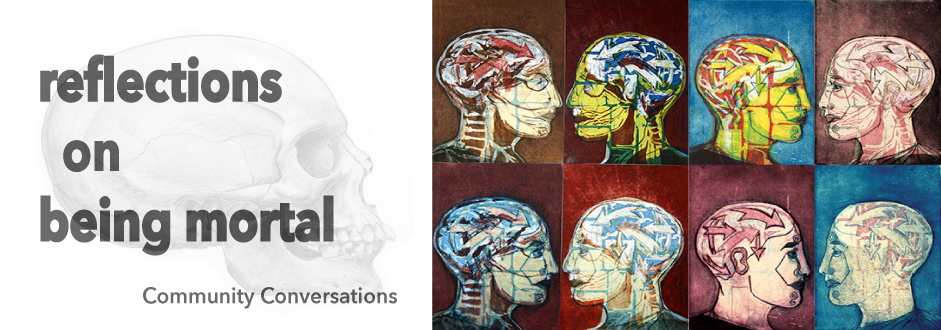Why Mortality? Why Health?
Our program focuses on the basic human fact of mortality. All of us, it's safe to say, would like to live long and happy lives, and those of us engaged in humanities research and teaching strive to make those lives more fulfilling and meaningful.
"Reflections on Being Mortal" is a program designed to empower individuals of the Central Illinois region to better fathom what it means to have “health,” to face “death,” and to communicate in the process what it is to be fundamentally human, fundamentally connected.
The program starts from two assumptions, one statistical and the other philosophical. First, most Americans have not clearly communicated (or even thought about) their wishes for the end of their lives. This is true of at least two-thirds of Americans, with the more highly educated and chronically ill population being more likely to have completed an advance directive. Second, the process of contemplating and reflecting seriously on death in relation to health is one that the humanities has traditionally addressed. To think about vitality and mortality, progress and demise, and beginnings and endings is just what philosophy, literature, history, music, art, anthropology, and language do.
Why now?
The Institute of Medicine’s 2014 report, Dying in America: Improving Quality and Honoring Individual Preferences Near the End of Life, calls for a national conversation on the issue of end-of-life care. One key finding of the report is that public education needs to do more to “normalize conversations about death and dying.” Our project proposes to strengthen public understanding of and reflections upon mortality, and, more specifically, ways of addressing the question, “why is there so little public conversation about dying and, conversely, so much talk about health”? Is the disproportionate focus on “health” a recent phenomenon? If so, what effect does this have on people’s understanding of the aging process and the inevitability of death?
It is hardly an exaggeration to say that in the last few years we have witnessed the beginnings of a process we might call the “mainstreaming” of death. Conversations about dying—as an event we plan for (how to die, when to die, whom to address along the way) and as a battleground of legal and ethical rights (the Death with Dignity Movement and state legislative bill debates)—have taken center stage in the public imagination. Indeed, consider together the basic underlying message of the remarkable case of an entire town signing advance directives (96% of the 50,000-resident La Crosse, Wisconsin), and of a recent episode of the television series Grace and Frankie, in which Frankie (played by Lily Tomlin) and, eventually, Grace (Jane Fonda) agree to help their friend with terminal cancer end her life, as but one example of many. These are strange, but not impossible, bedfellows: people need to have the conversation about how they want to die and to whom they entrust decision-making when expression is no longer a possibility.
Why the Humanities?
This project starts from two assumptions, one statistical and the other philosophical. First, most Americans have not clearly communicated (or even thought about) their wishes for the end of their lives. This is true of at least two-thirds of Americans, with the more highly educated and chronically ill population being more likely to have completed an advance directive. Second, the process of contemplating and reflecting seriously on death in relation to health is one that the humanities have traditionally addressed. To think about vitality and mortality, progress and demise, and beginnings and endings is just what philosophy, literature, history, ethics, music, art, anthropology, and language do.
We acknowledge the social importance of the technological apparatus (Google Death Manager, video advance directives on smartphones) and of the informative public service website (The Conversation Project, National Healthcare Decisions Day). Yet we see our project as a much-needed contribution to public discussion on dying and health, since what the humanities brings to the table is neither purely technological nor purely informative. In fact, the peculiar strength of a humanities approach lies in its unmatched ability to synthesize reason, emotion, curiosity, and creativity, harnessing all of this in the realm of problem-solving, on however large or small a scale.
We hope you will join us for the wide variety of programming we already started in 2017. Below, you will find a list of some of the opportunities we are planning to offer.
The image in the banner above, and on the carousel of our homepage, is taken from hematologist and artist Deborah Glencross's "Facing Convergence" (2010-11), Collection of the Adler Museum of Medical History, University of the Witwatersrand, Johannesburg. The image on this page is taken from a painting entitled "Lemminkäinen's Mother" (1897) by the Finnish artist Akseli Gallen-Kallela.


